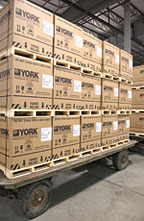
Others are essentially ready to clear out the old and bring in the new, hoping for a quick conversion of buyers to the new standard starting by mid-2005. They are encouraged by some contractors' growing sales of 13-and-higher-SEER equipment.
Recognizing the larger footprint of 13-plus-SEER units compared to those of 10- and 12-SEER equipment, distributors are expanding warehouse space and already computing the effect of trucking changes. The larger units will mean fewer systems shipped per truckload. Size might even affect what an installer can haul to a site.
Both Sides Of The Fence
A few distributors are simply holding back, waiting to see what the pricing will be on 13-SEER units and how builders, contractors, and homeowners will react.One distributor, who wished to remain unnamed, said "I don't think it [the impact of 13 SEER] is going to affect anybody dramatically until next year.
"Some tract builders will want to warehouse 10-SEER equipment. They're not going to pay a higher price. Most of them are putting in 10 SEER now and won't step up even to a 12 SEER because it costs them more money."
He expects that 12-SEER equipment may be an acceptable midpoint for such builders when 13 SEER is the minimum for newly manufactured systems.
While some builders and contractors will want "old style" equipment that will give them a price break, others may not settle for anything that doesn't meet current or emerging standards, distributors told The News.
Training of contractors and technicians on 13-SEER equipment is already well under way for some of the 12 distributors interviewed. Others said they are planning to start training programs early in 2005.
Koldaire Supply Co., Dallas, doesn't plan to stockpile any units with ratings below 12 SEER, according to Vice President Gary Moody. "Our dealers are going through the transition now," he said. "Three of my dealers right now are trying to sell nothing but 14 SEER and up, and they've done well with it.
"We're going to phase out [below-13-SEER] equipment over the next year and a half, and will be ready to go when 13 is the rule." His company, a Nordyne distributor, will start training classes to help in the transition. Moody is also Southwestern Region Chairman of Heating, Airconditioning & Refrigeration Distributors International (HARDI).

Stockpiling
Gerard Hazel, general manager of Staten Island (N.Y.) Heating & Cooling Supply, said his firm will stockpile some 10- and 12-SEER units; "I think a lot of people will." He attributes that to a very competitive, somewhat closed market with a lot of price-driven selling in his borough of New York City."We've seen some selling of 13-and-higher SEERs," he reports. He also plans to hold classes or training sessions, but hasn't started yet.
"We're in the process of setting up training programs to get our core customer base up to speed on the change," said Frank Raue, operations manager at Equipment Sales Corp. The Carrier and Payne distributor is headquartered in Mobile, Ala., and serves southern Alabama and Mississippi and northwest Florida.
However, the company began taking steps about two years ago to educate contractors about the forthcoming industry changes to at least 12 SEER.
Raue believes a lot of consumers and business owners are going to be shocked when they see the price difference between 10-SEER and 13-SEER systems. His company felt it would be better to "educate them now rather than getting a cold glass of water in the face in January of 2006."
Raue pointed out the second major impact on his company will involve the increase in physical size of 13-and-higher-SEER equipment, noting that his company was expanding its warehouse space.
Doug Young, president of The Behler-Young Co., a Bryant distributor with headquarters in Grand Rapids, Mich., is also studying the logistical impact of the change. "The 13 SEERs are about 80 percent larger than 10s in cubic footage," he said. "That means we need nearly twice as many trucks, nearly twice as much space in our distribution centers.
"The dealer can fit fewer units in his trucks, and installers will have to make more trips to take the same number of units to jobsites."
Young believes selling quality features beyond energy savings can help the industry avoid the pitfalls of price-only "commoditization" when 13 SEER becomes the new industry minimum. Quiet operation, ease of service, unit diagnostics, and a better appearance should be emphasized to appeal to customers when presenting higher SEER equipment, he said.
Should a distributor stockpile some sub-13 SEER units? "That's something we all want to know," said Dan Hinchman, vice president of corporate operations and marketing, Aireco Supply, Savage, Md.
"Our plan right now is to wait and watch a little. We also believe we'll start seeing 12- and 13-SEER product pricing drop. The market's going to push it that way," he said.
Price Sensitivity
"I think most contractors will be more inclined to sell higher efficiency product if the pricing differential is not as great as it is now," Hinchman said. "We have some price-sensitive customers who would probably like to deal sometime before the end of next summer on buying a bunch of 10-SEER product to save money going forward."What we've found in the past, however, when the move was from 8 to 10 SEER, that [advantage] didn't really materialize because the price of 10 SEER got down close to where 8 SEER was anyway, so no one really needed to do that.
"If the pricing differential stays high," he added, "yes, I think people will buy a lot of 10-SEER product next year and stock up for at least six months or a year." But such stockpiling is costly for many contractors, and the average distributor isn't going to carry a year's worth of inventory, Hinchman pointed out.
A bigger issue looms with warranty concerns. "Say a guy buys a brand new 10-SEER unit next September and it fails the following February," Hinchman said. "He can't get a 10 anymore; he has to get a 13, and the problem is will the 13 match up with his existing air-handler unit or will it give him any other problems."
A Bryant distributor in Orem, Utah, Contractors Heating & Cooling Supply, is already inventorying fewer 10- and 12-SEER units, reported president Blaine Hyde. He noted that contractors with a good, well-prepared sales force can sell higher-SEER equipment now if they talk directly to the homeowner or consumer.
Valair, a Carrier distributor headquartered in Sacramento, Calif., also doesn't anticipate stockpiling sub-13 SEER equipment, said Peggy Gonzales, vice president of operations.
"We will contact our customers who have used that type of product, but we're not going to try to hedge our bets and fill up our whole warehouse with the lower-efficiency products." The bulkier size of 13-SEER equipment and its effect on warehouse and truck planning "is something we will have to look into," she added.
"I don't know that we'll be stockpiling all that much" of lower-efficiency equipment as the 13-SEER deadline approaches, said Rod Rhoads, HVAC purchasing manager for Connor Co., a Tempstar and Rheem distributor with headquarters in Peoria, Ill.
"I think we'll keep a normal amount of inventory per history and then see how it goes."
Space Concerns
Both space and time measure the impact of the approaching 13 SEER deadline for Sigler & Reeves and Air Mechanical Supply in Phoenix, said Rod Martin, Sigler & Reeves vice president/residential sales manager.Sigler & Reeves has just built a 140,000-square-foot distribution center. The company will downsize some of its multiple warehouses in metropolitan Phoenix, then put smaller satellite units throughout the valley.
"The other impact from a distributor standpoint is managing inventory flow," said Martin. "When do you make your last buy of 10- and 12-SEER product moving forward in 2005? Do you buy a bunch of 10 SEER because you can sell it for 18 months past the December 31, 2005 deadline? If you buy a bunch, are they going to continue installing it throughout 2006?"
His experience in previous transitions (such as the switch to automatic ignition from match-lit in the 1980s and the move from 8-SEER to 10-SEER minimums in the early 1990s) suggests that builders will immediately move to the new product line "and don't want a whole lot of the old one."
Neither does the consumer, Martin believes. "They don't want to feel that they bought a unit that is not approved beyond 2006."
Jim Middleton, HVAC sales and product manager for The Thos. Somerville Co., Upper Marlboro, Md., said his firm hasn't yet decided whether to stockpile some sub-13-SEER product. "We'll address that as we find out more on what our customers are expecting from us."
The company is "very extensively involved" in training, now even more essential because contractors have to be certified to sell the Luxaire Acclimate line, a high-end system that his firm distributes. The one-day programs have been conducted mostly with factory-certified trainers brought in from Wichita.
The larger size of 13-SEER units is a concern for Buckeye Heating & Air Conditioning Supply, a Comfortmaker distributor serving the northeast Ohio market from its headquarters in Bedford Heights. John Wortendyke, president, said warehousing space is a concern. Fewer boxes on a truck will also drive up the shipping cost per item.
He hopes for a rapid, smooth transition to 13 SEER as a minimum standard.
"We try to do the changeout quickly and have very little of the old stuff in stock." His company's training programs for contractors and technicians on high-efficiency systems will probably get under way strongly in February.
Publication date: 12/13/2004

Report Abusive Comment